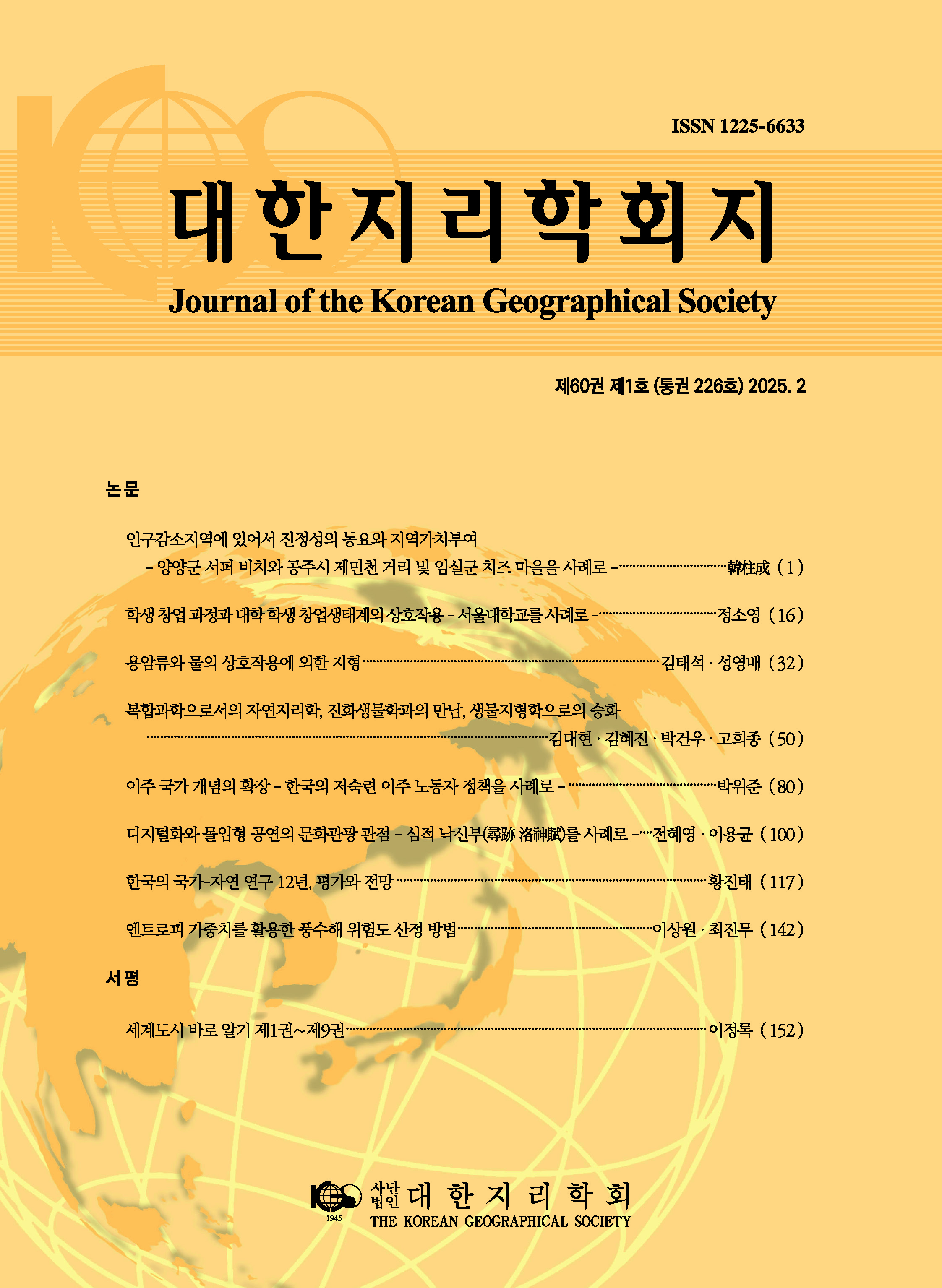Research Article
구한민・홍사흠, 2023, "지역일자리, 대체될 것인가 지속할 것인가?: 지역 특성이 기술진보에 따른 일자리 대체 가능성에 미치는 영향," 대한지리학회지, 58(2), 135-146.
윤선중・서종현, 2021, "기술 중소기업의 경영 특성에 대한 고성장 기업 결정 영향 요인 분석: 4차 산업혁명기업과 일반 중소기업을 중심으로," 벤처창업연구, 16(6), 157-175.
한영미・임호순・박광태・최민, 2018, "4차 산업혁명 시대의 주요 서비스업종을 통한 일자리 창출 전략," 중소기업연구, 40(4), 51-74.
10.36491/APJSB.40.4.3Acemoglu, D. and Autor, D., 2011, Skills, tasks and technologies: implications for employment and earnings, Handbook of Labor Economics, 4, 1043-1171.
10.1016/S0169-7218(11)02410-5Aghion, P., Antonin, C., Bunel, S. and Jaravel, X., 2022, The Effects of Automation on Labor Demand: A Survey of the Recent Literature, Discussion Paper No. DP16868, CEPR, London, England.
10.4324/9781003275534-2Alic, J. A., 1997, Technological change, employment, and sustainability, Technological Forecasting and Social Change, 55(1), 1-13.
10.1016/S0040-1625(96)00166-7Angel, D. P. and Mitchell, J., 1991, Intermetropolitan wage disparities and industrial change, Economic Geography, 67(2), 124-135.
10.2307/143541Arntz, M., Gregory, T. and Zierahn, U., 2017, Revisiting the risk of automation, Economics Letters, 159, 157-160.
10.1016/j.econlet.2017.07.001Aubert-Tarby, C., Escobar, O. R. and Rayna, T., 2018, The impact of technological change on employment: the case of press digitisation, Technological Forecasting and Social Change, 128, 36-45.
10.1016/j.techfore.2017.10.015Autor, D. H., 2015, Why are there still so many jobs? the history and future of workplace automation, Journal of Economic Perspectives, 29(3), 3-30.
10.1257/jep.29.3.3Autor, D. H., Levy, F. and Murnane, R. J., 2003, The skill content of recent technological change: an empirical exploration, The Quarterly Journal of Economics, 118(4), 1279-1333.
10.1162/003355303322552801Becker, G., 1964, Human Capital: A Theoretical and Empirical Analysis, with Special Reference to Education, Columbia University Press, New York, NY.
Berg, A., Buffie, E. F. and Zanna, L. F., 2016, Robots, growth, and inequality, Finance & Development, 53(3), 10-13.
Bessen, J., 2019, Automation and jobs: when technology boosts employment, Economic Policy, 34(100), 589- 626.
10.1093/epolic/eiaa001Black, D. A., Kolesnikova, N. and Taylor, L. J., 2014, Local labor markets and the evolution of inequality, Annual Review of Economics, 6(1), 605-628.
10.1146/annurev-economics-080213-040816Borts, G. H. and Stein, J. L., 1964, Economic Growth in a Free Market, Columbia University Press, New York, NY.
Casado-Diaz, J. M., 2000, Local labour market areas in Spain: a case study, Regional Studies, 34(9), 843-856.
10.1080/00343400020002976Chen, S. C., Jiang, W. and Ma, Y., 2020, Decent work in a transition economy: an empirical study of employees in China, Technological Forecasting and Social Change, 153, 119947.
10.1016/j.techfore.2020.119947Conroy, M. E., 1975, The concept and measurement of regional industrial diversification, Southern Economic Journal, 41(3), 492-505.
10.2307/1056160Crespi, G. and Zuniga, P., 2012, Innovation and productivity: evidence from six Latin American countries, World Development, 40(2), 273-290.
10.1016/j.worlddev.2011.07.010Curry, R., 2023, August 10, How A.I. Can Help Create Jobs for Humans, not Just Automate Them, CNBC, https://www.cnbc.com/2023/08/10/how-ai-can-help-create-jobs-for-humans-not-just-automate-them.html, Accessed September 13, 2023.
Davis, D. J. and Rubin, B. A., 2016, Displacement in new economy labor markets: post-displacement wage loss in high tech versus low tech cities, Social Science Research, 60, 29-44.
10.1016/j.ssresearch.2016.04.00527712686Fee, K. and Hartley, D., 2011, Urban Growth and Decline: The Role of Population Density at the City Core, Federal Reserve Bank of Cleveland, Cleveland, OH.
10.26509/frbc-ec-201127Frey, C. B. and Osborne, M. A., 2013, The Future of Employment: How Susceptible Are Jobs to Computerisation?, Oxford Martin School, Oxford, England.
Frey, C. B. and Osborne, M. A., 2017, The future of employment: how susceptible are jobs to computerisation?, Technological Forecasting and Social Change, 114, 254-280.
10.1016/j.techfore.2016.08.019Gibbs, M. B., 2022, How Is New Technology Changing Job Design?, IZA World of Labor, Bonn, Germany.
10.15185/izawol.344.v2Goos, M., Manning, A. and Salomons, A., 2014, Explaining job polarization: routine-biased technological change and offshoring, American Economic Review, 104(8), 2509-2526.
10.1257/aer.104.8.2509Higano, Y. and Shibusawa, H., 1999, Agglomeration diseconomies of traffic congestion and agglomeration economies of interaction in the information oriented city, Journal of Regional Science, 39(1), 21-49.
10.1111/1467-9787.00122Holzer, H. J., 1989, Employment, Unemployment and Demand Shifts in Local Labor Markets, The National Bureau of Economic Research, Boston, MA.
10.3386/w2858Hoogstra, G. J., Van Dijk, J. and Florax, R. J., 2017, Do jobs follow people or people follow jobs? a meta-analysis of Carlino-Mills studies, Spatial Economic Analysis, 12(4), 357-378.
10.1080/17421772.2017.1340663International Federation of Robotics, 2023, World Robotics 2023, VDMA Services GmbH, Frankfurt, Germany.
Kim, C. and Mauborgne, R., 2023, May 3, The Fourth Industrial Revolution Is Here. Here's What it Means for the Way We Work, Fast Company, https://www.fastcompany.com/90890678/the-fourth-industrial-revolution-is-here, Accessed August 26, 2023.
Köves, A., Király, G., Pataki, G. and Balázs, B., 2013, Backcasting for sustainable employment: a Hungarian experience, Sustainability, 5(7), 2991-3005.
10.3390/su5072991Li, Y., Dai, J. and Cui, L., 2020, The impact of digital technologies on economic and environmental performance in the context of industry 4.0: a moderated mediation model, International Journal of Production Economics, 229, 107777.
10.1016/j.ijpe.2020.107777Lindley, J. and Machin, S., 2014, Spatial changes in labour market inequality, Journal of Urban Economics, 79, 121-138.
10.1016/j.jue.2013.07.001Martens, B. and Tolan, S., 2018, Will This Time Be Different? A Review of the Literature on the Impact of Artificial Intelligence on Employment, Incomes and Growth, JRC Digital Economy Working Paper 2018-08, Joint Research Centre, Brussels, Belgium.
10.2139/ssrn.3290708McFadden, D., 1977, Quantitative Methods for Analyzing Travel Behaviour of Individuals: Some Recent Developments, Cowles Foundation Discussion Papers, 707, Coweles Foundation, New Haven, CT.
Muth, R. F., 1971, Migration: chicken or egg?, Southern Economic Journal, 37, 295-306.
10.2307/1056181Nedelkoska, L. and Quintini, G., 2018, Automation, Skills Use and Training, OECD Social, Employment and Migration Working Papers, Organization for Economic Cooperation and Development, Paris, France.
Oliveira, R. C. d. and Silva, R. D. d. S. e. 2023, Artificial intelligence in agriculture: benefits, challenges, and trends, Applied Sciences, 13(13), 7405.
10.3390/app13137405Organization for Economic Cooperation and Development, 2019, The Future of Work: OECD Employment Outlook 2019, Paris, France.
Schreiber, S., 2008, The Hausman test statistic can be negative even asymptotically, Jahrbücher für Nationalökonomie und Statistik, 228(4), 394-405.
10.1515/jbnst-2008-0407Schwab, K., 2016, January 14, The Fourth Industrial Revolution: What It Means, How to Respond, World Economic Forum, https://www.weforum.org/agenda/2016/01/the-fourth-industrial-revolution-what-it-means-and-how-to-respond, Accessed August 29, 2023.
Simon, C. J., 1988, Frictional unemployment and the role of industrial diversity, The Quarterly Journal of Economics, 103(4), 715-728.
10.2307/1886071Steinnes, D. N., 1982, Do 'people follow jobs' or do 'jobs follow people'? a causality issue in urban economics, Urban Studies, 19(2), 187-192.
10.1080/00420988220080311Steinnes, D. N. and Fisher, W. D., 1974, An econometric model of intraurban location, Journal of Regional Science, 14, 65-80.
10.1111/j.1467-9787.1974.tb00430.xTopel, R. H., 1986, Local labor markets, Journal of Political Economy, 94(3), S111-S143.
10.1086/261401van Dam, K., van Vuuren, T. and Kemps, S., 2017, Sustainable employment: the importance of intrinsically valuable work and an age-supportive climate, The International Journal of Human Resource Management, 28(17), 2449-2472.
10.1080/09585192.2015.1137607William, J., 2023, December 28, AI Advancements Risk 30000 Google Jobs, DevX, https://www.devx.com/news/ai-advancements-risk-30000-google-jobs, Accessed January 5, 2024.
Wirtz, J., Kunz, W. and Paluch, S., 2021, The service revolution, intelligent automation and service robots, European Business Review, 29(5), 909.
- Publisher :The Korean Geographical Society
- Publisher(Ko) :대한지리학회
- Journal Title :Journal of the Korean Geographical Society
- Journal Title(Ko) :대한지리학회지
- Volume : 59
- No :3
- Pages :350-368
- Received Date : 2024-03-22
- Revised Date : 2024-05-23
- Accepted Date : 2024-05-27
- DOI :https://doi.org/10.22776/kgs.2024.59.3.350




 Journal of the Korean Geographical Society
Journal of the Korean Geographical Society







